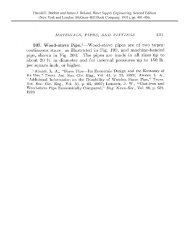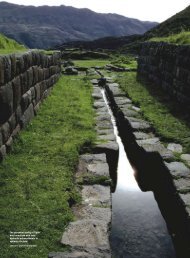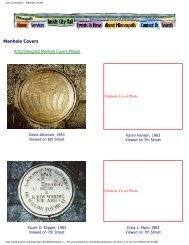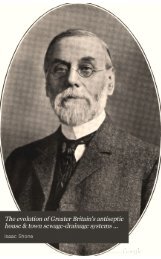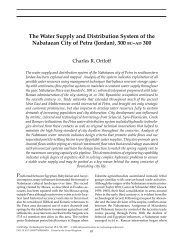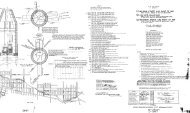our discussion on CCTV United States - The History of Sanitary ...
our discussion on CCTV United States - The History of Sanitary ...
our discussion on CCTV United States - The History of Sanitary ...
Create successful ePaper yourself
Turn your PDF publications into a flip-book with our unique Google optimized e-Paper software.
<strong>on</strong> emulsi<strong>on</strong> and its cinematography methods are several more decades.<br />
In 1926 Philo Farnsworth and Vladimir Zworkin simultaneously designed a camera, which utilised image<br />
pickup and sensing technique. Zworkins’ design focused an image through a lens <strong>on</strong>to an array <strong>of</strong><br />
photoelectric cells coating the end <strong>of</strong> a tube. <strong>The</strong> electrical image formed by the cells would be scanned<br />
line by line by an electr<strong>on</strong> beam, and transmitted to a Cathode Ray Tube or CRT. Hence we are familiar<br />
with the term CRT today. C<strong>on</strong>versely, Farnsworths' image dissector device used an anode finger to scan<br />
the picture.<br />
This was a pencil sized tube with an aperture at the<br />
top. Magnetic coils sprayed the electr<strong>on</strong>s omitted<br />
from the electrical image left to right and line by line<br />
<strong>on</strong>to the aperture where they became an electric<br />
current. Farnsworths’ device worked pretty well,<br />
although could not produce an image serious<br />
amounts <strong>of</strong> light were required for operati<strong>on</strong>. It was<br />
however, the beginning <strong>of</strong> video collecti<strong>on</strong> as we<br />
know it today. Zworkin and Farnsworth's devices then<br />
transmitted the current to a cathode ray tube, which<br />
recreated the image by scanning <strong>on</strong>to a fluorescent<br />
Figure 4.<strong>The</strong> 1927 versi<strong>on</strong> <strong>of</strong> Farnsworth’s image<br />
dissector. He received a patent for the image<br />
dissector in 1930, and successfully defended that<br />
patent against Vladimir Zworykin and David<br />
Sarn<strong>of</strong>f. C<str<strong>on</strong>g>our</str<strong>on</strong>g>tesy: Smiths<strong>on</strong>ian Instituti<strong>on</strong>. S<str<strong>on</strong>g>our</str<strong>on</strong>g>ce:<br />
http://www.ieee-virtual-museum.org/collecti<strong>on</strong><br />
surface. Zworkin and the vice president <strong>of</strong> RCA,<br />
David Sarn<strong>of</strong>f visited the laboratory <strong>of</strong> Farnsworth and<br />
downplayed the importance <strong>of</strong> Farnsworths<br />
experiments and Farnsworths services, saying" there<br />
is nothing here that we will need". RCA worked with<br />
Zworkin and together they ensured that RCA would<br />
c<strong>on</strong>trol and dominate the televisi<strong>on</strong> industry for the<br />
foreseeable future. In 1934, RCA, dem<strong>on</strong>strated its'<br />
"Ic<strong>on</strong>oscope", a design, very similar to Farnsworths image dissector and the patent wars begun. Through<br />
years <strong>of</strong> turmoil, RCA was compelled to pay royalties to Farnsworth, but truly the design started by<br />
Farnsworth had been left behind, <strong>on</strong>ly the c<strong>on</strong>cept <strong>of</strong> capturing video line by line in an array and the<br />
transmissi<strong>on</strong> sequence remained. By the time World War II began, Farnsworth realised that the real<br />
m<strong>on</strong>ey was in TV commercials and being a businessmen, not an inventor in his laboratory. With his<br />
patent about to expire he reluctantly sold his company to RCA in 1949. Now RCA truly c<strong>on</strong>trolled and<br />
dominated the televisi<strong>on</strong> industry.<br />
<strong>The</strong> first US manufacturer <strong>of</strong> <strong>CCTV</strong> pipeline surveillance equipment was established in 1946 by a major<br />
manufacturer <strong>of</strong> large power plant boiler systems to fill a need that was not available <strong>on</strong> the commercial<br />
market. <strong>The</strong> company had just finished commissi<strong>on</strong>ing a large 1 mega-watt power generati<strong>on</strong> system for<br />
a Virginia Utility and several days after start-up the boiler lost water and exploded, placing the boiler out<br />
<strong>of</strong> service for over a year. Water level gauges are located approximately 3 storeys above the c<strong>on</strong>trol room<br />
and prior to the development <strong>of</strong> <strong>CCTV</strong> gauge viewing, a system <strong>of</strong> mirrors was used to reflect the gauge<br />
image to the c<strong>on</strong>trol room. One <strong>of</strong> the mirrors at Virginia Electric Power had been damaged and the<br />
c<strong>on</strong>trol room was not able to m<strong>on</strong>itor the gauge. When the water level dropped below the minimum the<br />
boiler exploded and was heavily damaged.<br />
<strong>The</strong> boiler manufacturer searched the available technologies and found that towards the end <strong>of</strong> the<br />
Sec<strong>on</strong>d World War, <strong>CCTV</strong> had been used aboard naval ships for remote viewing. A search <strong>of</strong> patents<br />
revealed that Philo Farnsworth had been issued a patent <strong>on</strong> an image dissector televisi<strong>on</strong> pickup tube.<br />
<strong>The</strong> boiler manufacturer purchased the rights and began manufacturing remote <strong>CCTV</strong> gauge viewing<br />
systems using the Farnsworth design. <strong>The</strong>se cameras were very large, heavy, had 200-line resoluti<strong>on</strong>,<br />
bad distorti<strong>on</strong> and required a lot <strong>of</strong> light and power.<br />
RCA c<strong>on</strong>tinued to dominate the marketplace for numerous years. <strong>The</strong> c<strong>on</strong>sumer market was however<br />
demanding the use <strong>of</strong> col<str<strong>on</strong>g>our</str<strong>on</strong>g> televisi<strong>on</strong> to keep up with demand with the ever popular col<str<strong>on</strong>g>our</str<strong>on</strong>g> cinema<br />
movies. RCA was forced to accelerate research <strong>on</strong> electr<strong>on</strong>ic col<str<strong>on</strong>g>our</str<strong>on</strong>g> televisi<strong>on</strong> well before the market for<br />
black and white had been saturated. Under the directi<strong>on</strong> <strong>of</strong> Paul Schnitzler the challenge was to<br />
Paper F-4-04 - 4




